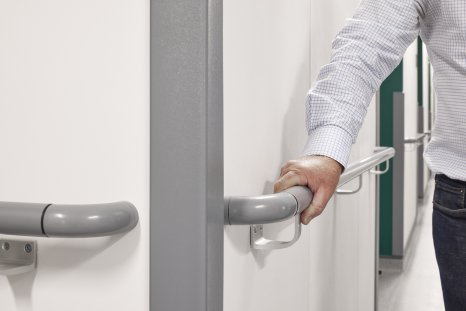Corners are one of the most vulnerable areas of any building. As a result, installing corner guards will reduce long-term maintenance costs and maintain interior appearances in environments ranging from healthcare, education and pharmaceutical, through to commercial office, retail, hospitality, and transport.
Wherever they are used, corner guards conceal existing damage and prevent further damage – as well as helping the building maintain its appearance, reducing maintenance costs, minimising collisions, and upholding hygiene levels.
In healthcare environments, they can also be used to help wayfinding, as detailed in the Health Building Notes (HBN). Another benefit of corner guards to healthcare buildings is that damaged corners can harbour dirt and bacteria and are difficult to clean. The installation of corner guards therefore improves hygiene through damage limitation.
By considering the five points below, you can help ensure that you specify the correct corner guards for your healthcare building:
1. Speed/weight of traffic
Some areas within a healthcare building will experience heavy wheeled traffic, such as trolleys, medical equipment, wheelchairs, beds, and catering trolleys. For these types of applications, we would recommend high-impact corner guards at full height. The aluminium retainer provides a reinforced defence against high-impact damage, combined with a shock absorbent vinyl cover, which can be easily replaced when damaged.
2. Volume of traffic
Where traffic volume is low, such as an office or family waiting room, a standard corner guard would be suitable. In contrast, high-impact corner guards protect more effectively over the long-term against high-traffic volume areas.
3. Hazards
Corner guards can be fitted to warn building users of potential hazards. They should be installed at full height and use a colour tone that is 30 points of LRV difference to the wall. This enables highlighting of columns or ducts, for example, that project into circulation areas.
4. Wing thickness
The general rule is the bigger the better, as the wider the wing, the more of the corner surface is protected. The larger wing size also enables mechanical fixing to be applied further away from the apex of the corner. Gradus offers a 50mm and a 75mm wing size.
5. Height
Consider what you’re trying to protect against, as damage can be caused at numerous points. Trolleys and equipment may come into contact at mid-height, cages and catering trolleys at higher levels, and vacuum cleaners and parcel trolleys may strike lower down. If you are unsure about the future level and type of traffic, we would suggest that you install high impact corner guards at full height. This will help to future-proof your facility and to protect your long-term budget. We offer seven height options to suit most budgets and applications.
Click here to see our full range of corner guards.
Please send any questions to imail@gradus.com or call 01625 428 922.



